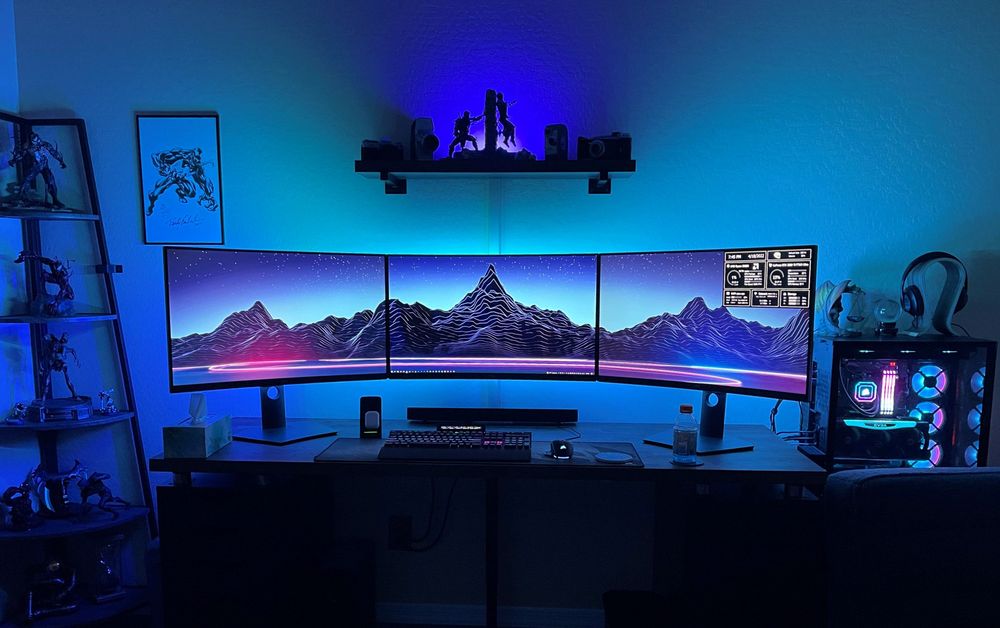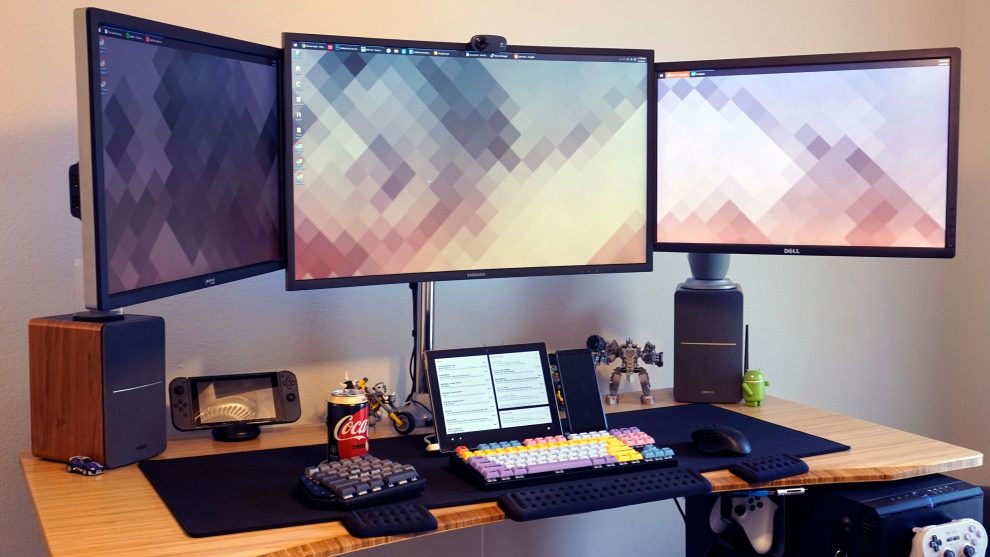Do you dream of having an expansive desktop workspace to seamlessly multitask and boost your efficiency? Enter the triple monitor workstation – the ultimate solution for serious multitaskers seeking unmatched screen real estate for work or play.
A properly set up triple display configuration can vastly improve productivity, enhance immersion in games and media, and even reduce workspace clutter. But embarking on a triple screen setup requires planning and effort to do it right.
In this comprehensive guide, we’ll walk you through the entire process of choosing equipment, arranging your displays, adjusting software settings, and customizing your new enviable command center to match your needs and style.
Step 1: Evaluate Your Needs and Available Space
Before choosing any hardware or making physical changes to your workspace, start by asking yourself these key questions:
- What will I primarily use the triple monitor setup for – office work, gaming, graphic design, day trading? Your main activities should drive the gear selection process.
- How much physical desk space can I devote to this project? You’ll need ample room for three displays plus stands or mounts. Don’t forget to account for ideal viewing distance as well.
- What’s my total budget for this upgrade? Costs can range widely depending on monitor specs, stands, necessary upgrades to your PC hardware, and other accessories.
Step 2: Select Your Displays, Stands, and Connection Cables
The displays will likely be your biggest investment for a triple screen workstation, so choose wisely here! You’ll want displays that match in their underlying specifications like resolution, refresh rates, and connectivity options. Here are key factors to consider:
Monitor Size and Aspect Ratio
24-27 inch monitors are the most popular options, but consider going up to 32+ inches for maximum immersion. Ultrawide monitors with 21:9 aspect ratios are also excellent choices. Just be sure you have the desk space!
Resolution and Panel Technology
For sharper image quality, look for monitors with QHD 2560 x 1440 or 4K UHD 3840 x 2160 resolutions. This does require a more powerful graphics card. For gaming and animation, opt for faster TN panel types. For color critical work, look to IPS panels.
Refresh Rate
Faster refresh rates (120Hz, 144Hz, 240Hz) result in a smoother, more responsive feel for gaming and video. For general office work, 60Hz will suffice.
Response Time
Favor monitors with lower response times (1ms, 2ms) to eliminate ghosting or motion blur during fast on-screen motion.
Hardware Connectivity
Choose monitors that offer flexible connectivity via HDMI, DisplayPort, and other legacy ports to easily interface with your PC or laptop.
Monitor Stands
A sturdy triple monitor stand, with articulating arms for adjustment, minimizes desktop footprint while allowing for ergonomic fine-tuning. You can also opt for wall mounts to free up desk space.
Cables
Stock up on cables like HDMI, DisplayPort, or USB-C to connect your displays. Opt for higher quality cables that can handle the bandwidth of fast refresh rates and resolutions.

Step 3: Plan Out Monitor Placement
Now comes the fun part – setting up your physical workspace! Start by laying out where your three displays will live on your desk. Some popular configurations include:
- Primary center display – Place your most used monitor directly in front of you for easiest access and gaming.
- Sidecar displays – Flank your primary display with slightly angled side monitors for expanded peripheral view.
- Full panoramic – Align three monitors evenly for a seamless wide aspect ratio desktop.
Be sure to observe proper monitor height, distance, and angle best practices too. You’ll likely need to make incremental adjustments over time to discover your optimal ergonomic positioning.
Step 4: Connect Your Monitors and Configure Display Settings
With your physical workspace arranged, it’s time to wire up your monitors and configure your multi-display setup in software.
Connect Display Cables
Carefully plug your cables (HDMI, DisplayPort, etc) into the appropriate ports on both your computer and each monitor.
Configure Display Settings
In Windows, head to Settings > System > Display. Here you can arrange your displays according to their physical placement, set priorities between primary and side displays, match orientation, and tweak resolutions.
Take time to align edges perfectly between adjacent displays for a seamless transition of your mouse cursor between them.
Adjust Refresh Rate
Still in Display Settings, you can also tailor refresh rates to each monitor. Set your main display at max refresh rate for gaming, secondary displays can likely remain at standard 60Hz.
Calibrate Colors
For color-critical work, use monitor built-in tools or dedicated calibration hardware like the Datacolor SpyderX to fine tune colors across displays.
Step 5: Customize Software for Your Workflow
You now have a fully operational triple screen workstation! But to maximize productivity potential, make sure to customize software settings to best complement your workflow:
Set Default Programs
In Windows Settings, assign default programs for common tasks like web browsing, email, media playback etc. This determines which monitor newly opened apps load on.
Organize App Windows
The added screen space invites clutter. Use FancyZones in Windows or Magnet on macOS to intelligently snap program windows across your expanded canvas.
Take Advantage of Virtual Desktops
Create separate virtual workspaces via Mission Control on Mac or Task View on Windows 10/11 to keep discrete tasks organized.
Game immersion plugins like AMD Eyefinity and NVIDIA Surround also help span games across side-by-side displays.
Limit Eye Strain with Pro Monitor Ergonomics
Staring at three displays all day poses increased risk of headaches, eye fatigue, and back/neck stiffness if you’re not careful.
Practice these monitor health tips:
- Position monitors at proper height, distance, angle per your height and seat.
- Break the 20/20/20 rule by looking away every 20 minutes for 20 seconds at something 20 feet away.
- Keep blinking! This keeps eyes from drying out as you concentrate.
- Invest in an anti-glare screen protector and blue light blocking glasses.
- Use night light mode or apps like Iris at night to reduce exposure to sleep-disrupting blue light.
And make sure to get up and move around hourly. Your long-term health is priority #1!
Conclusion
Constructing an exceptional triple monitor command station requires planning, quality gear, ergonomic optimization, and personal customization.
But the investment pays off many times over through heightened productivity, cleaner workspace arrangement, and truly incredible immersion into gaming or media worlds.
So follow this comprehensive guide through the essential steps of assembling your dream workstation. Once dialed in, that gigantic multi-display desktop expanse will transform how you create, work, and play!
















Add Comment